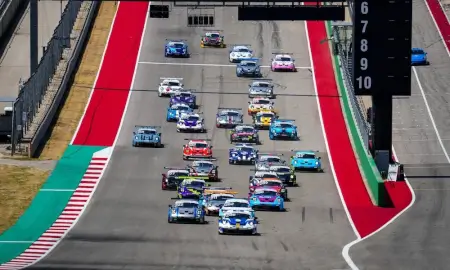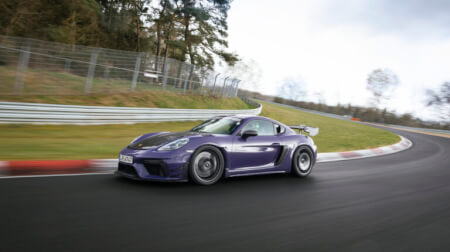July 30th 2022
Porsche unveils the next generation of its GT3 race car
On the heels of the 992 generation of the 911 road car and the 992-based GT3 Cup, Porsche has now revealed the next generation of the 911 GT3 R at the TotalEnergies 24 Hours of Spa. The new challenger for GT3 series around the world, including IMSA WeatherTech SportsCar Championship and the SRO Fanatec GT World Challenge America, is based on the current 992 generation of the 911 platform and will be ready to race at the beginning of the 2023 season.
Porsche Motorsport began developing the next generation of its GT3 racer in 2019, with priority given to further improving the drivability for drivers with various skillsets, given that many GT3-based championships are built around gentleman drivers, as well as tapping larger performance reserves for different Balance of Performance classifications. Another focus was on streamlining the handling of the race car for the teams and reducing the running costs. Porsche Motorsport now offers the new 911 GT3 R to North American customers at a price of $567,210 and optional extras. In the United States and Canada, the new racer is only available through Porsche Motorsport North America.
“In North America, GT3 is the top category of GT racing, as it soon will be around the world,” commented Volker Holzmeyer, president and CEO of Porsche Motorsport North America. “This made the new generation of the 911 GT3 R especially important to our market. Its development, which incorporates not only lessons learned from the previous generation GT3 R but also from the GT3 Cup one-make car as well as the 911 RSR, has made this car very appealing to our customer teams. Drivability is remarkably important to the wide range of drivers that we have competing here and that was a focus of the type 992 911 GT3 R. We have already had overwhelming interest in the car, and we are looking forward to seeing it turn its first wheel here soon.”
After the GT3 class was announced as a professional category, GTD PRO, in the IMSA WeatherTech SportsCar Championship, the FIA World Endurance Championship will follow suit. Beginning in 2024, GT3 racing cars such as the new 911 GT3 R will be eligible to take part in the 24 Hours of Le Mans for the first time, adding to dozens of series worldwide where GT3 cars are eligible to compete.
“We hit the bull’s eye with the enormously successful predecessor. Accordingly, the bar for its successor is high,” says Sebastian Golz, 911 GT3 R Project Manager at Porsche Motorsport. “Our task was less about making the new 911 GT3 R even faster — the classification within performance windows set by the BoP quickly cancels out this advantage. For us, it was primarily about our customers being able to drive the car fast for longer. This requires durability and that’s why we focused predominantly on improved drivability. This is reflected in the new 4.2-liter engine’s broader usable rev band, more stable and constant aerodynamics and lower loads on the rear tires, which allow their potential to last longer.”
At the core of the new racing car is the near-standard engine based on the 992- generation 911 powerplant. Like in the previous model, it is a water-cooled flat-six engine with four-valve technology and direct fuel injection. The main new development is the displacement. Like the 911 RSR, the capacity of the new 911 GT3 R has increased by a five percent from 3,997 to 4,194 cc. This has boosted the normally aspirated engine’s peak output to around 565hp. More importantly, however, Porsche has optimized the torque and power curve across the entire rev range. Consequently, the new 4.2- liter six-cylinder is better suited for a wider range of driver experience.
The engine has been tilted forward by 5.5 degrees, creating more space for the underbody diffuser. Auxiliary components such as the alternator and the air conditioning compressor were moved significantly forward and further down into a space in front of the engine and gearbox, which has a positive effect on the weight balance of the 911 GT3 R. The sequential six-speed contest-mesh gearbox is derived from the current 911 GT3 Cup race car. Shift paddles control an electronic shift drum actuator that enables particularly rapid and precise gear changes.
The new 911 GT3 R’s suspension allows more precise steering, contributes to a reduction in wear on the rear tires and reduces the time spent on set-up changes. Set-up modifications are done with shims, enabling precise adjustments without the need for the time-consuming re-alignment of the suspension afterwards.
The optimized positioning of the central pivot points at the front axle frees space for the aerodynamic “race underfloor” concept that allows for a clean flow of air to the rear diffuser and reduces the pitch sensitivity of the racing car
In the cockpit, the seat has moved closer to the center of the car. This enabled Porsche to optimally adapt the more ergonomic seat position to the improved roll cage and the newly developed FIA side impact protection mandates. Like in the predecessor, the steering wheel and pedals can be adjusted longitudinally to suit the driver while maintaining a fixed seat mount.
Porsche specialists took another close look at the six-point harness. The tongues now slide even faster into the clasp via special ramps — saving about a second during pit stops for driver changes. The steering wheel incorporates elements that have proven themselves in the latest generation 911 GT3 Cup and 911 RSR race cars. The 10.3-inch display, for example, comes from the successful one-make cup racer, with the multi-switch concept adopted from the Le Mans class winner.
Like the new Porsche 963 LMDh car, the 992 911 GT3 R is expected to make its North American competition debut at the 2023 Rolex 24 at Daytona.
For more information: www.racer.com
For more information: www.racer.com














